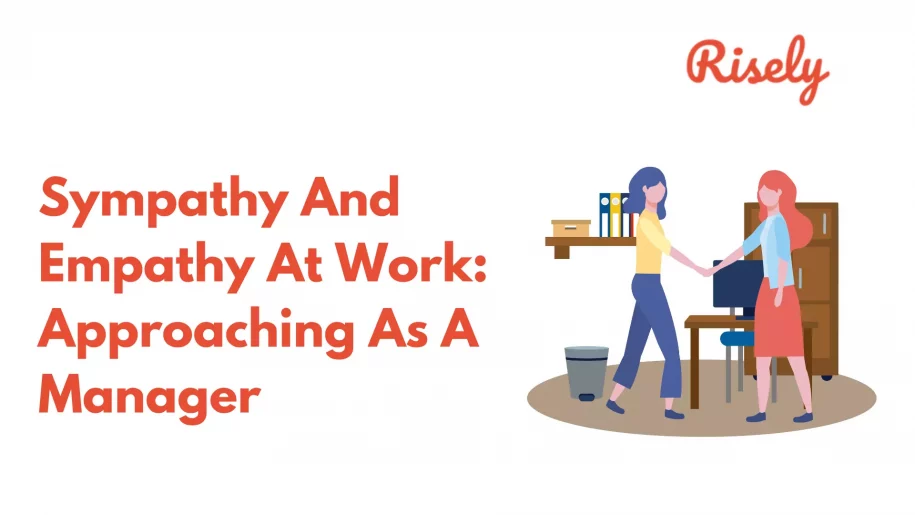Sympathy And Empathy At Work: Approaching As A Manager
Managers are constantly under pressure to make decisions that will affect the company. Sometimes, these decisions may be challenging and require Empathy or Sympathy to understand the other person’s feelings. However, which approach is best for managers? There is a lot of confusion surrounding both terms as some people even consider them synonyms, but they are not. In this blog, we aim to provide a clear definition for both terms and explain the pros and cons of each. By the end of the blog, you will better understand which strategy is better for you as a manager.What do you mean by Sympathy?
The definition of Sympathy is the feeling of pity and sorrow for someone else’s misfortune or emotional pain. Sympathy is a powerful emotion that can cause people to take action to help a person or maybe a coworker suffering or facing some sadness. It is often confused with empathy, but they are different. Sympathy is caring and feeling sorry for a person going through a tough time. It is the ability to understand the feelings of the other person. When you sympathize with someone, you show them that you know how it feels to be in that situation and that you are there to support them. In the context of managers, showing Sympathy to employees can come in many ways and bring significant pros and cons. What are those pros and cons? Let’s see.Pros of showing Sympathy
- Higher Productivity: Sympathy conveys understanding and concern, making employees feel appreciated and supported. This can lead to increased productivity and job satisfaction.
- Trust and loyalty: Managers who show Sympathy to their employees are more likely to engender trust and loyalty among their team. This is because when employees witness their managers’ concern for them, they’ll be motivated to stay loyal to both the team and the manager.
- Improved communication: When employees witness their manager showing concern for them, they are more likely to be open, honest, and communicate effectively with their manager. This can lead to better decisions and improved team morale.
- Better coordination: Sympathy makes it easier for employees to cooperate as they know that the manager is on their side and is concerned about their feelings. This can lead to smoother workflows and cooperative strategies among teams of employees.
Cons of showing Sympathy
- Partiality: When managers show Sympathy to employees, it can send the wrong message to the rest of the team. If some employees are seen as “special” and receive preferential treatment, it can create resentment, distress, and division within the team.
- Too much burden for managers: It can be challenging for managers to draw the line between sympathizing with employees and taking on their problems as their own. Managers can quickly become overburdened if they constantly try to help employees with their challenges.
- Unrealistic expectations: When employees feel that their manager is constantly sympathizing with them, they may begin to believe that the manager is obligated to help them solve every problem. So, they’ll start using the sympathy card in front of the manager in the smallest of inconveniences. This can lead to false optimism and may even result in ineffective management of the team.
- Emotional stress: While Sympathy may be free from some of the costs associated with empathy (such as time and energy), it can still have a cost in terms of emotional stress for managers. This is because showing Sympathy involves a lot of emotional labor, which may make managers emotionally exhausted.
What do you mean by empathy?
Empathy is the capacity to understand and share the feelings and emotions of another person. It is a cognitive process through which we can place ourselves in another person’s shoes and feel what they are feeling. Empathetic people respond to others with compassion and understanding rather than judgment or criticism. Empathy is essential for building strong relationships, both professionally and personally. It enables us to step in some other person’s shoes and see the world from the other person’s perspective instead of one’s perspective and connect with them on a deeper level. We can use empathy to resolve conflicts and create a more positive and supportive workplace culture. A manager showing empathy to their employees also has pros and cons. What are those? Let’s see.OtherInterestingReads
Pros of showing empathy
- Greater employee commitment: First, when employees feel that their manager understands them and cares about them as people, they are likely to be more committed to their work. They will also be more likely to take suggestions and constructive criticism from their manager seriously.
- Better Communication: When managers can empathize with their employees, it allows for better and more effective communication. An empathetic manager will emphasize listening to employees and better understanding their situations. The employees will be more likely to open up and share their thoughts and feelings with the manager.
- Improved Cooperation: Empathy is a powerful tool that can enhance cooperation among team members. When managers can understand their employee’s situations, it promotes collaboration among everyone involved in that particular situation.
- Increased Teamwork: When managers can empathize with their employees, it increases teamwork within the workplace. Employees who know their manager cares about them will be more willing to help out in any way possible.
- Reduced Conflict and Stress: When managers can empathize with their employees, it reduces conflict within the workplace. Employees who know they are understood and cared for will be less likely to resist or disagree with the manager’s decisions.
Cons of showing empathy
- Difficulties in management: Overly empathetic Managers may have trouble making tough decisions or setting boundaries with employees. They may also find it difficult to provide critical feedback or hold employees accountable. All that will lead to ineffective management of the team.
- Manipulation: If not careful, someone can harness the empathetic tendencies of managers to manipulate them into cruelty, aggression, and other negative behaviors.
- Overwhelming: Being too empathetic can lead to managers being consistently overwhelmed or even getting emotionally drained eventually.

Which is better for managers to practice?
When interacting with employees, what should managers exhibit between empathy and Sympathy? The answer is that it depends. To better understand it, let’s know the critical difference between the two. Empathy and Sympathy are two different ways of responding to someone else’s suffering. Sympathy is when you feel bad for someone because of their situation. Empathy is when you understand and share the feelings of another person. Empathy allows managers to understand how their employees are feeling and to better relate to them. However, Sympathy shows them they are concerned about their employees. So which is better for managers to use? Sympathy or empathy? The answer may depend on the situation. Understanding and sharing your employees’ feelings is critical; sometimes, a little sympathy can go a long way. If someone is going through a tough time, Sympathy can be an excellent way to show that you care. Empathy may be helpful when you need to understand someone’s experience to resolve a problem. Ultimately, both Sympathy and empathy are essential tools for managers. So, it is clear that for managers, both empathy and Sympathy are essential traits to exhibit. The only difference in practicing both is that Sympathy will be necessary for some specific situations (employees going through a bad phase). However, practicing empathy is a continuous process that helps manage the team effectively. Therefore, managers should aim to maintain a fine line between both. They should choose to practice any of the two based on their and their employees’ situations. A good mix of both will go a long way and enable the manager to manage their team effectively.Conclusion
To conclude, it is clear that both Sympathy and empathy are essential traits for managers to practice. It’s just that empathy is a continuous process. Sympathy, on the other hand, is restricted to certain situations. To manage their teams effectively, especially in difficult times, managers need to maintain a good balance between both traits to fulfill the emotional needs of their team.Adopt active listening to know your team more.
Download the free active listening toolkit to learn and practice the sympathy & empathy within your team.
FAQs
What is the importance of showing sympathy and empathy at work?
Showing empathy and sympathy at work helps managers and leaders get closer to their teams. As a result, they can create more cohesive teams based on trust and loyalty.
How do you show sympathy in the workplace?
The best way for managers to show sympathy at work is being present when the team member needs them. You can also help them solve challenges and guide as an understanding coach.
How do you show empathy in the workplace?
A few signs of an empathetic manager are: – Understanding the signs of fatigue and burnout – Acknowledging your team member’s ideas – Involving the team in decisions
How do empathy and sympathy go hand-in-hand?
Empathy and sympathy go hand-in-hand as the ability to put oneself in the place of others helps managers become better at understanding the concerns of someone else.
Other Related Blogs
Healthcare Leadership Coaching: A Beginner’s Guide
Healthcare Leadership Coaching: A Beginner’s Guide Healthcare leadership plays a crucial role in driving excellence in patient care and the overall success of the healthcare industry. However, healthcare leaders face…
Performance Management Training: Empowering Managers To Manage Better
Performance Management Training: Empowering Managers To Manage Better Remember that feeling of dread when you knew performance review season was rolling around? Yeah, us, too. For many employees, performance reviews…
One-on-one Meetings That Don’t Make Your Team Sigh
One-on-one Meetings That Don’t Make Your Team Sigh One-on-one meetings! If you are anywhere close to a performance review session, your calendar might be crowded by the team. But there’s…
Grooming for Management: The Key to Building a Sustainable Leadership Pipeline
Grooming for Management: The Key to Building a Sustainable Leadership Pipeline Imagine a crucial leadership position opening up in your organization. You scramble to fill the role, internally and externally,…


